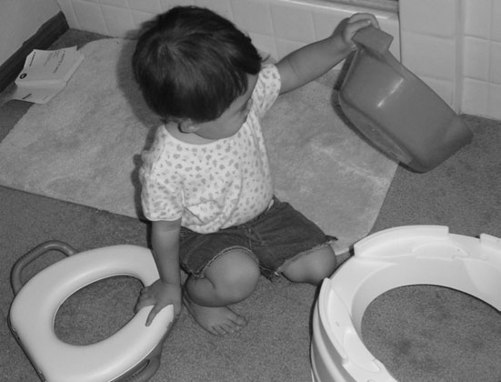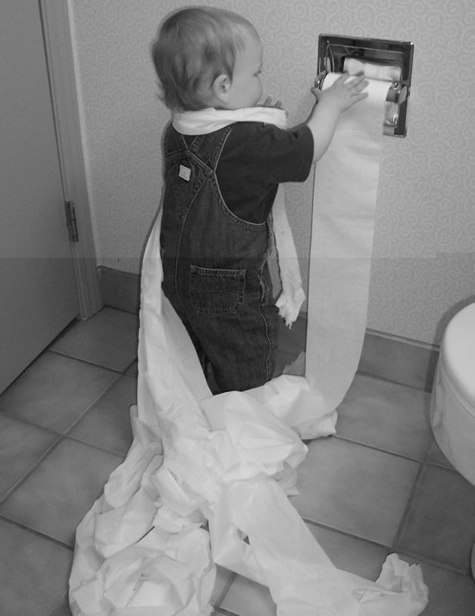The No-cry Potty Training Solution (11 page)
Read The No-cry Potty Training Solution Online
Authors: Elizabeth Pantley

It’s Potty Time! Setting Up
69
Mother-Speak
“I think the most important thing to keep in mind is that this is their accomplishment and milestone, not ours. It’s important to be sensitive to their timeline. The more we support them in having their own success and their own accomplishment (with as little emotional attachment on our part as possible), the quicker the success and the more pleasant the experience for child and parents!”
—Natasha, mother of seventeen-month-old Jubal
and five-year-old Max
When your child’s daily routine is disrupted or when he’s overtired, hungry, or overstimulated, it’s likely that he’ll have more accidents and be more forgetful about what he’s supposed to be doing.
Teaching your child how to use the toilet can seem to take forever. Between dry runs and actual potty calls, you might find yourself taking him to the toilet up to a dozen times a day! That adds up to 84 separate visits to the bathroom over a week’s time and some 360 visits in a month! (I know what you’re thinking. If she would have told me that on page 1, I might have bought a box of diapers instead of this book.)
One way to keep perspective is to jot down the starting date of potty training and note another date three months in the future. Know that you’ll be your little one’s potty partner for at least those three months.
Remember, on average it takes three to twelve months from the start of training until your child will be going to the bathroom independently.
This page intentionally left blank
5
A Menu of Potty Training
Ideas
Every child is different, every parent is different, and every toilet training situation is entirely different; for those reasons, it’s foolhardy to think that one exact method will work the same way with every family. Lots of people are misled into trying a plan that worked beautifully for someone else but that falls flat for them, because it doesn’t mesh with their family’s unique personality. Many of the basic principles of potty training will be common to all, but the variations on the process are vast. So take a little time to map out your plan before you get started or before you start over after a previously unsuccessful attempt at potty training.
This chapter provides you with many suggestions and ideas. So grab a pen or highlighter and read through these pages with your particular needs in mind, mark-ing as you go. Then decide what exactly you’ll be doing over the next few months.
Introduce the Potty
Sure, your child has been in the room when you’ve used the toilet. But chances are she’s had no clue what 71

72
The No-Cry Potty Training Solution
Kyleigh, sixteen months old
you were up to. She’s also been eliminating in her diaper without giving it a thought for a long time. The idea of doing her business in the potty is almost certainly a brand-new concept—“You want me to do
what?! Where?!
” In some ways this will be like teaching your child a second language, so first things first.
Tell her what’s what.
Either take your child with you to select a potty chair or present one to her with a flourish. Give a brief lesson about what it’s for, and then let her investigate this new contraption. Don’t expect that she’ll totally understand right off. It will take some time for her to really come to terms with how the potty will fit into her life.
If you haven’t yet, start reading books to your child about other children who are learning to use the potty.
I’d suggest that you read more than one or two, because
A Menu of Potty Training Ideas
73
some will make more sense to her than others, and she’ll likely pick up an important point or two from each one. You might even want to write your own potty book, as discussed later in this chapter.
A few casual conversations about pee, poop, and the potty are helpful, too. If you haven’t before, start announcing your own trips to the bathroom so your child can observe that you do this new thing, too.
Just Sitting There Is Success
When you first get started, just getting your busy toddler to
sit
on the potty for more than ten seconds is progress! Toddlers are full of energy, and during the learning time, your child may find it rather difficult to sit still long enough for something to actually happen.
It might even be confusing to her, and she may be wondering, “What the heck am I supposed to do here, anyway?” You may want to read, sing, or talk with her while she is sitting so that she’ll stay for longer than a moment or two. It won’t be until she makes a few deposits into her potty or the toilet that she’ll grasp exactly what you expect to happen when you have her sit there.
Praise your child for going through the actions of getting to the potty and sitting there, even if it’s just for a moment. Let her know that you’re proud of her
attempts.
Don’t Expect a Deposit Every Time!
At first, there will be lots and lots and
lots
of dry runs.
Also, your trainee may wet or soil his diapers or training pants immediately after getting off the potty. This 74
The No-Cry Potty Training Solution
is because it’s necessary to relax the muscles for elimination to occur. When potty training is a new event, your child will likely be excited, tense, or distracted while sitting on the pot and will then relax as soon as a diaper or training pants are in place.
Remember, too, that your child has been used to eliminating while standing or even while on the go. Sitting still in one place to do his business is a new and unfamiliar concept and will take some getting used to.
Don’t worry and don’t scold if your child continues to make dry runs. He’s not doing this to annoy you; he just can’t quite read his body signals yet. Give him time.
He’ll get it all figured out eventually.
At first, put a few pieces of toilet paper into the bottom of the potty, so that even a few drops of pee can be seen. If your child is using a toilet, put a few drops of blue food coloring into the water. Adding a bit of yel-low urine will turn the water green, which will surely fascinate your child. You can also do this in a potty chair with a tablespoon or two of blue water.
Give Wiping and Toilet Paper Lessons
Children seem to have a hard time figuring out how much toilet paper to use. They either use too little, ending up with a messy hand, or use too much and can’t control the wiping process. It will take a number of lessons before they get it right.
If you can use a tangible way to measure the paper, that works best. Common measuring tools are an arm’s stretch length, counting squares, or unrolling the paper down to the floor.

A Menu of Potty Training Ideas
75
Tristan, thirteen months old
If the toilet paper tube unrolls too fast and your child ends up with an excess amount, you can squeeze the roll a bit so that it flattens out and slows the unraveling.
Wiping after a bowel movement is a big job for little ones. It will take time for them to master this task, and 76
The No-Cry Potty Training Solution
they likely will not be doing it completely on their own until a year or more after completing their potty training. Be sure to teach your little girl to wipe from front to back to prevent infections.
Teach your child to wipe while sitting down. Children have a tendency to get up first and then wipe, which often leaves a smear along the toilet seat as they climb off.
You can start by doing the wiping and then let your child finish up. After a time, your child can start and you can finish up. Teach boys and girls to wipe until the paper is clean, which could take two or three fresh pieces of paper. A great idea is to use flushable diaper wipes for the first wipe and toilet paper for the second.
Make It a Routine
It will take quite a while for your little one to remember to even ask to go. She’ll have to learn how to read her body signals, understand what they mean, and act on them by stopping what she’s doing and making the trip to the bathroom. An active toddler who is concentrating on play will often miss the signals or hope they’ll go away so that she can finish her activity. She may also misjudge how long she has before her holding control stops. She may think she can put off going to the potty, but eventually her natural response will be to release, no matter where she is.
To help your child learn how this all works, have her sit on the potty at regular times at first—for example, when she first wakes up, after meals, before a bath,




